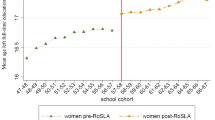Abstract
This study reviews the evidence on the possible contribution that a publicly supported child care program could make to the stock of human capital that future generations will bring into the nation's labor force, focusing on the development of children most at risk of future poverty and dependency.
The analysis first discusses the potential benefits to individuals, and to society at large, of increased human capital investment. Next, evidence is reviewed on how pre-school programs have affected educational attainment. The link between educational attainment and earning capacity is then examined using evidence drawn from census surveys as well as a limited amount from longitudinal studies of pre-school alumni. In conclusion the evidence supports the claim that investment in child care, incorporating tested developmental components, can yield net benefits to society by enhancing the human capital of upcoming generations.
Similar content being viewed by others
References
Baily, M.N. (1988). ‘Productivity and American Management,’ in Litan et al. (1988).
Bishop, J.H. (1989). ‘Is the Test Score Decline Responsible for the Productivity Growth Decline?’ in The American Economic Review 79: 178–197.
Barnett, W.S. (1985). ‘The Perry Preschool Program and Its Long-Term Effects: A Benefit-Cost Analysis,’ High/Scope Early Childhood Policy Papers, No.2, Ypsilanti: High/Scope Press.
Beller, E.K. (1983). ‘The Philadelphia Study: The Impact of Preschool on Intellectual and Socioemotional Development,’ in Consortium for Longitudinal Studies (1983).
Belsky, J. and L.D. Steinberg (1978). ‘The Effects of Day Care: A Critical Review,’ in Child Development 49: 929–949.
Berrueta-Clement J.R., Schweinhart, L.J., Steven Barnett, W., Epstein A.S. and D.P. Weikart (1984), Changed Lives: The Effect of the Perry School Program on Youths through Age 19, Ypsilanti: High/Scope Press.
Bureau of Labor Statistics (1982), Labor Force Statistics Derived from the CPS: A Databook, VOL. I, Department of Labor, Bureau of Labor Statistics, Washington: G.P.O.
Census Bureau (1983), ‘Lifetime Earnings Estimates for Men and Women in the United States: 1979,’ Current Population Reports, Consumer Income, Series P-60, no. 139. U.S. Department of Commerce, Bureau of the Census, Washington D.C.: G.P.O.
Census Bureau (1984), Statistical Abstract of the U.S. 1985, U.S. Department of Commerce, Bureau of the Census, Washington D.C.: G.P.O.
Clarke-Stewart, K.A. (1987), In Search of Consistencies in Child Care Research, in D.A. Phillips, Ed. (1987).
Clarke-Stewart, K.A. and G.G. Fein (1983), ‘Early Childhood Programs,’ in P.H. Mussen (ed.) Handbook of Child Psychology, New York: John Wiley and Sons.
Committee on Labor and Human Resources (1989a), U.S. Senate, 101st Congress, Hearings before the Subcommittee on Children, Family, Drugs and Alcohol, Jan. 29, 1989, Washington D.C.: G.P.O.
Committee on Labor and Human Resources (1989b), U.S. Senate, 101st Congress, Calendar No. 43, Report 101–17, ‘Act for Better Child Care Services of 1989,’ Washington D.C.; G.P.O.
Committee on Ways and Means (1989), U.S. House of Representatives, 101st Congress, ‘Poverty, Income and Tax Burden Distributions, Wealth and Homeless Statistics,’ in Background Material and Data on Programs within the Jurisdiction of the Committee on Ways and Means, 1989 Edition, Appendix I, Washington D.C.: G.P.O.
Consortium for Longitudinal Studies (1983), As the Twig is Bent: Lasting Effect of Preschool Programs, Hillsdale, New Jersey: Lawrence Erlbaum Associates.
Copple, C.E., Marvin. G., Cline M.G. and A.N. Smith (1987), ‘Path to the Future: Long-Term Effects of Head Start in the Philadelphia School District,’ Head Start Bureau, Administration for Children Youth and Families, HDS/DHHS, Washington D.C.
Council of Economic Advisors (1986), Economic Report of the President, 1986, Executive Office of the President, Council of Economic Advisors, Washington D.C.: G.P.O.
Golden, M., Rosenbluth, L., Grossi, M., Policare, H., Freeman, H. and Brownlee, E. (1978), ‘The New York City Infant Day Care Study,’ Medical and Health Research Association of New York City, New York.
Gray, S.W., Ramsey, B.K. and Klaus R.A. (1983), ‘The Early Training Project: 1962–1980,’ in Consortium for Longitudinal Studies (1983).
Hanuschek, E.A. (1986), ‘The Economics of Schooling: Production and Efficiency in Public Schools’, in Journal of Economic Literature 24: 141–1177.
Karnes, M.B. (1983), Shwedel, A.M. and Williams, M.B., ‘A Comparison of Five Approaches for Educating Young Children from Low-Income Homes,’ in Consortium for Longitudinal Studies (1983). Litan, R.E., Lawrence, R.Z. and Schultze, C.L., Eds., (1988) American Living Standards: Threats and Challenges, Washington, D.C.: The Brookings Institution.
McKey, R.H., Condelli, L., Ganson, H., Barrett, B.J., McConkey, C. and Plantz, M.C. (1985), The Impact of Head Start on Children, Families and Communities: Head Start Synthesis Project, prepared for the Head Start Bureau, Administration for Children, Youth and Families, DHHS, Washington, D.C.
Murnane, R.J. (1988), ‘Education and the Productivity of the Work Force: Looking Ahead,’ in Litan et al. (1988).
Phillips, D.A. and Howes, C. (1987), ‘Indicators of Quality in Child Care: Review of Research,’ in Phillips, ed. (1987).
Phillips, D.A., ed., Quality in Child Care: What Does Research Tell Us, Research Monograph Series, Vol. I, Washington, D.C.: National Association for the Education of Young Children.
Reischauer, R.D. (1987), ‘The Size and Characteristics of the Underclass’, Paper presented at the APPAM Research Conference, October 29–31, 1987, Bethesda, Maryland.
Royce, J.M., Darlington, R. and Murray, H. (1983), ‘Pooled Analyses: Findings Across Studies,’ in Consortium for Longitudinal Studies (1983).
Sawhill, I.V. (1989), ‘The Underclass: An Overview,’ in The Public Interest 96: 3–15.
Schorr, L.B. (1988), with Daniel Schorr, Within Our Reach: Breaking the Cycle of Disadvantage, New York: Doubleday.
Smith, J.P. (1989), and Welch, F.R., ‘Black Economic Progress After Myrdal,’ in Journal of Economic Literature 27: 519–564.
Westinghouse Learning Corporation (1969), ‘The Impact of Head Start: An Evaluation of the Effects of Head Start on Children's Cognitive and Affective Development,’ Washington, D.C.: Clearinghouse for Federal Scientific and Technical Information.
Author information
Authors and Affiliations
Rights and permissions
About this article
Cite this article
Donovan, S., Watts, H. What can child care do for human capital?. Popul Res Policy Rev 9, 5–23 (1990). https://doi.org/10.1007/BF00124899
Issue Date:
DOI: https://doi.org/10.1007/BF00124899




